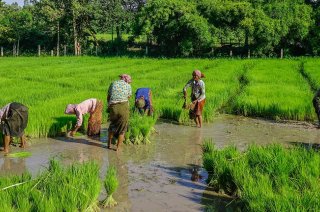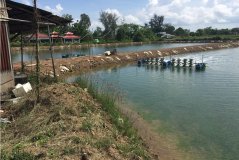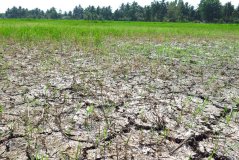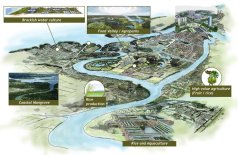
Longread
Mekong Delta: Vietnam’s rice bowl transitions into a diverse food basket
In 1975, following the war, Vietnam faced a massive famine. With help from Wageningen, the Mekong Delta rapidly became the second-largest rice producing region in the world. Forty-five years later, Wageningen University & Research is still involved, but its focus now is on future-proofing the delta in the face of climate change and global market demands. Using the Food Systems Approach, policymakers are gaining insights into all of the factors and interests that play a role in this region.
Cover photo: Rice plantation in the Vietnamese Mekong Delta (Phuong D. Nguyen / Shutterstock.com)
Food Systems Approach
In the run-up to the United Nations Food Systems Summit this fall, we zoom in on countries in which Wageningen University & Research applies and develops the Food Systems Approach (see end of article) in collaboration with local governments, farmers, consumers, businesses and NGOs. This edition: Vietnam.
After a 20-year war, what Vietnam really needed was food
The vivid green rice fields of the Mekong Delta often grace the pages of travel brochures. But the region wasn’t always such a picture of fertility. For a long time, the soil was too acidic for rice cultivation. Then, with help from Wageningen’s researchers, in the late 1970s the delta developed into the ‘rice bowl’ of Vietnam. But the communist regime’s rice first policy has since become an anachronism. Vietnam actually produces more rice now than its people can eat, and the country earns very little from exporting it.
The Vietnamese government is now trying to maintain the Mekong Delta’s position as a prime food production region by encouraging farmers to grow other crops, along with shrimp and seaweed. This can certainly be done, says Gerardo van Halsema, a researcher at the Water Resources Management group who has worked on projects in Vietnam for more than 20 years. “But only if Vietnam takes into account external factors such as climate change and the demands of the global market.”

Technological solutions
Vietnam’s food system is much more complex now than it was 45 years ago. “After a 20-year war, in 1975 what the country really needed was food,” explains Van Halsema. “Rice filled stomachs. It was a question of finding technological solutions to maximise rice production.” That was where Wageningen came in. After all, the Mekong Delta looks remarkably similar to the Netherlands: it’s a coastal region, and flat as a pancake. In the early 1980s, Wageningen researcher Nico van Breemen discovered that the Mekong Delta, like the dry coastal regions of the Netherlands, struggled with ‘cat clay’, or acidified soil. Another WUR researcher, Tini van Mensvoort, found a way to deal with this: by constantly flushing the soil with fresh water. Higher dikes were also built, which protected the rice fields from the Mekong River when it flooded.
Climate change and soil change
The impact was phenomenal: between 1975 and 1995, Vietnam shot up to become the second-largest rice producer in the world, after Thailand. But sooner or later, says Van Halsema, intensive agriculture in a delta will lead to subsidence and salinisation, as the Netherlands knows only too well. “The Mekong Delta lies on average one metre above sea level. If subsidence brings it down even lower, you’ll inevitably be faced with floods. And that process is now exacerbated by climate change: rainy seasons are becoming more extreme, which means the Mekong breaks its banks even more easily, while on top of that sea levels are rising which means seawater encroaches and causes salinisation of the soil.”

Besides rice, consumers also want fruit, vegetables and fish
Feeding the world requires more than just rice
Plus: markets are changing. Not only does population growth mean more food is needed – both within Vietnam and around the world – but the market also demands greater diversity, says Dang Kieu Nhan, director of the Mekong Delta Development Research Institute, part of Can Tho University and a partner of WUR. “Besides rice, consumers also want fruit, vegetables and fish,” says Dang. “Those products can be grown in the Mekong Delta, and they already are. In the higher parts of the delta a lot of rice is still being grown, but downstream you can already find other products such as maize, sesame and potatoes. And in the coastal areas prawn cultivation is taking off.”
- Unfortunately, your cookie settings do not allow videos to be displayed. - check your settings
According to Van Halsema, the Vietnamese government is fully on board with the diversification that WUR has been urging since the start of the millennium. This support is based on a recognition that diversification helps safeguard the livelihoods of farmers (who will then remain in the Mekong Delta) and ultimately increases Vietnam’s revenues. “We can see very clearly that living standards for farmers are improving, with better housing and children attending school,” says Dang.
But he stresses that the farmers do rely on the government for that transition to work. “If they grow much more fresh produce, then those products need to be transported quickly. It means you need to travel 200km from Can Tho to the harbour in Ho Chi Minh City.” On top of that, certification schemes need to be introduced to ensure food safety, says Dang. “Western markets in particular insist on far fewer pesticides being used, and proof of compliance with that. So then you need an institute to assess that.”
Resilience = embracing climate change
Perhaps the most important job for the government is to protect the region from climate change. But fighting high water levels – like Vietnam has done for so long – is actually pointless, says Van Halsema. “It’s understandably frustrating, because after all Vietnam has little influence on the water levels of the Mekong River. The amount of water flowing into the country is regulated by dams in China and Laos. But there’s very little you can do about that, so you’re better off concentrating on what you can change within your own borders.”
And when it comes to climate change, his recommendation is to embrace it. “Constantly raising the height of your dikes is pointless. It’s better to give the Mekong enough space and use the surrounding land for whatever you can grow there. We tried to demonstrate that in the Mekong Delta Plan (2013, jointly with the Dutch embassy in Vietnam, Deltares and Royal HaskoningDHV – ed.), funded by the Netherlands Enterprise Agency (RVO) and the Partners for Water programme. The World Bank approved $300 million to implement this.”

It’s better to give the Mekong enough space and use the surrounding land for whatever you can grow there
A plan for each region
Giving the river more space means that areas at higher elevations can only produce two rice harvests per year rather than three, and that the rest of the land can be used for aquaculture. That combination is more lucrative, Van Halsema explains. In slightly lower-lying regions mixed cropping is possible, with rice grown when there’s plenty of water and fruits and vegetables grown in dryer periods (using water stored during the rainy season).
“You need to avoid groundwater being used for cultivation, because it’s really needed for drinking.” That’s precisely why farming freshwater fish such as tilapia and pangasius is discouraged in areas close to the sea, and is being replaced with polycultures of shrimp and fish in salt-water basins. “There’s a lot of enthusiasm for shrimp and they fetch a high price,” says Van Halsema. “And if you cultivate them in mangrove forests, you also protect the coastline.”

Food system as a balancing act
Wageningen has been using the Food Systems Approach for the past few years as a way of analysing the increasingly complex food system in the Mekong Delta. Jan Verhagen of Wageningen Plant Research is an expert in this. “You need to see a food system as a balancing act, with a range of intertwining factors and interests. For local policymakers it’s often difficult to maintain oversight, not least because decision making is spread across different ministries. The Ministry of Agriculture will look at soil, while in economic affairs they look at revenues, and in environment it’s the effects of climate change.”
Using the Food Systems Approach you can consider all of the socio-economic and environmental drivers within a single model. “The main objective for Vietnam is to ensure that the Mekong Delta is a rich food production region,” says Verhagen. “The delta should no longer be Vietnam's rice bowl: it should be its food basket. But to make it future proof, you have to consider consumers, producers and the environment. That’s why the Food Systems Approach has four distinct objectives: 1. Enough food for everyone, 2. A healthy diet, 3. A fair distribution of costs and revenues along the food supply chain and 4. Sustainability and the maintenance of biodiversity.”
The need for reforms takes root
The communist regime in Vietnam is essentially a top-down structure, but it has operated a free market economy since 1986. While it hasn’t always been easy, WUR researchers Verhagen and Van Halsema have seen how the Food Systems Approach is gradually gaining a foothold. Dang has seen it on the ground: “There’s been close contact between researchers and the government for decades now. Particularly since the extreme floods of 2011 and extreme drought of 2016, Hanoi can see that sustainability – including the sustainability of the food system – is essential. But we’re not there yet. We need to get the farmers on board. This is a major transition for them.”
Shrimp fetch high prices and if you cultivate them in mangrove forests, you also protect the coastline
Farmers adapt
The amount of land dedicated to rice cultivation in the Mekong Delta is already less now than it was 20 years ago, but the Vietnamese government still wants rice production to shrink even further – from 24.5 million tonnes per year to 16 million tonnes – with high-value crops and products replacing it. Dang and Van Halsema are therefore busy setting up regional agro business hubs, as outlined in the 2013 Mekong Delta Plan. The idea is that these hubs will train farmers and make it easier for them to work together in cooperatives. This will make them better equipped to negotiate with the middlemen who tend to have little interest in sustainability.
The hubs will also act as an interface between farmers and the market, says Van Halsema. Convincing the farmers won’t be an issue, he adds. “Time and again, they’ve demonstrated how well they can adapt to new policy, the impacts of climate change and new market demands. Every year, their land use changes by 14 per cent. That’s extremely high.”